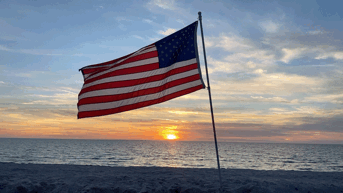One of the first black preachers in America was John Marrant.
Born a free black in New York in 1755, his father died when he was young.
He traveled with his mother to Florida, Georgia and South Carolina. He learned how to read, play the violin and the French horn.
In 1770, as a teenager during the Great Awakening Revival, Marrant was taken to hear evangelist George Whitefield in Charleston, South Carolina, and he came to Christ.
Being vocal about his new faith, he was rejected by his family.
Marrant wandered away and lived in the woods trusting God to provide. He was befriended by Cherokee and learned their language.
As tensions grew prior to the Revolution, with British inciting Indians, Marrant was arrested by the Cherokee chief and almost executed.
Providentially, he preached to the chief, who converted, and gave him complete permission to proclaim the Gospel among the entire tribe.
He also preached to the Creek, Catawba and Housaw.
John Marrant returned to South Carolina where he preach among slaves.
When the Revolutionary War broke out, he was impressed into the British navy and taken to England where he preached for years.
He later returned to preach the Gospel in Nova Scotia to "a great number of Indians and white people" at Green's Harbour near Newfoundland.
The missionary-minded Countess of Huntingdon published A Narrative of the Lord's Wonderful Dealings with John Marrant, a Black, which became incredibly popular and went through 17 editions.
George Liele was another early American black preacher.
Born a slave in Virginia in 1750, he was taken to Georgia in 1752.
When he was 23, he heard Baptist preacher Rev. Matthew Moore and converted.
Liele later wrote that he “saw my condemnation in my own heart, and I found no way wherein I could escape the damnation of hell, only through the merits of my dying Lord and Savior Jesus Christ."
George Liele attended the Buckhead Creek Baptist Church, with his master, Henry Sharp, who was a deacon.
Henry Sharp encouraged Liele's preaching and freed him.
Liele gained a following and organized them into a congregation in Silver Bluff Baptist Church in Beach Island, South Carolina, 1773 - considered one of the first black congregation in America.
One of Jonathan Bryan's slaves, Andrew Bryan, converted, was freed, and became the pastor of the congregation -- First Bryan Baptist Church -- one of the first black Baptist churches in North America.
The Savannah Baptist Association wrote on the occasion of his death in 1812 (The Wallbuilder Report, 2005)::
"The Association is sensibly affected by the death of the Rev. Andrew Bryan, a man of color, and pastor of the First Colored Church in Savannah.
This son of Africa, after suffering inexpressible persecutions in the cause of his divine Master, was at length permitted to discharge the duties of the ministry among his colored friends in peace and quiet, hundreds of whom, through his instrumentality, were brought to knowledge of the truth 'as it is in Jesus.'"
In 1778, when the British captured Savannah during the Revolution, David George went with the British to Nova Scotia, where he founded a black Baptist church.
Then in 1792, he went with the British to Freetown, Sierra Leon, and started another black Baptist church.
Alan Neely wrote in the Biographical Dictionary of Christian Missions (NY: Macmillan, ed. Gerald H. Anderson, 1998, 400-1):
"In order to be evacuated with other royalists and British troops, Liele obtained a loan and accepted the status of indentured servant to pay the passage for himself, his wife, and his four children on a ship bound for Jamaica.
Landing there in January 1783, he soon repaid the debt and secured permission to preach to the slaves on the island.
Thus by the time William Carey — often mistakenly perceived to be the first Baptist missionary — sailed for India in 1793, Liele had worked as a missionary for a decade, supporting himself and his family by farming and by transporting goods with a wagon and team.
Apparently, he never received or accepted remuneration for his ministry, most of which was directed to the slaves.
 ... He preached, baptized hundreds, and organized them into congregations governed by a church covenant he adapted to the Jamaican context.
... He preached, baptized hundreds, and organized them into congregations governed by a church covenant he adapted to the Jamaican context.
By 1814 his efforts had produced, either directly or indirectly, some 8,000 Baptists in Jamaica.
At times he was harassed by the white colonists and by government authorities for 'agitating the slaves' and was imprisoned, once for more than three years.
While he never openly challenged the system of slavery, he prepared the way for those who did; he well deserves the title 'Negro slavery’s prophet of deliverance.'
George Liele died in Jamaica."
As a young man, Richard's master, Stokley Sturgis, gave him permission to attend Methodist religious meetings, where he learned to read.
In the year 1777, at the age of 17, Richard Allen was converted and determined to work even harder to prove that Christianity did not make slaves slothful.
Methodists were against slavery, as founder John Wesley had called it "that execrable sum of all villainies."
After Allen's master heard that on the Day of Judgment slaveholders would be "weighed in the balance and found wanting," he converted and made arrangements for Richard to become free.
Richard Allen became a licensed exhorter, and in 1783, set out preaching in Delaware, New Jersey, Pennsylvania and Maryland, walking so much that his feet became severely blistered.
Their first church building was dedicated by Bishop Francis Asbury in 1794.
Dr. Benjamin Rush and George Washington contributed to Richard Allen's church.
In 1816, Allen led in the forming of an entirely new denomination, the African Methodist Episcopal Church, which was the first African-American denomination organized in the United States.
Jarena Lee became the first woman to receive "authorization" to preach, with Richard Allen giving his approval.
Allen supported AME missionaries, including Rev. Scipio Beanes, who was sent to Haiti in 1827.
"God Our Father,
Christ Our Redeemer,
the Holy Spirit Our Comforter,
Humankind Our Family."
"I was born in the year of our Lord 1760, on February 14th, a slave to Benjamin Chew, of Philadelphia ...
My mother and father and four children of us were sold into Delaware State, near Dover, and I was a child and lived with him until I was upwards of twenty years of age,
during which time I was awakened and brought to see myself poor, wretched and undone, and without the mercy of God must be lost ...
I went with my head bowed down for many days. My sins were a heavy burden. I was tempted to believe there was no mercy for me. I cried to the Lord both night and day.
One night I thought hell would be my portion. I cried unto Him who delighteth to hear the prayers of a poor sinner; and all of a sudden my dungeon shook, my chains flew off, and glory to God, I cried.
My soul was filled. I cried, enough, for me -- the Saviour died."
"This land, which we have watered with our tears and our blood, is now our mother country, and we are well satisfied to stay where wisdom abounds and Gospel is free."

Richard Allen was invited, but declined, to preach in Southern States with the circuit-riding preacher Francis Asbury -- America's first Methodist Bishop.
Hosier later accompanied other Methodist Bishops: Rev. Richard Whatcoat, Rev. Freeborn Garretson, and Rev. Thomas Coke.
"I really believe he is one of the best preachers in the world.
There is such an amazing power that attends his preaching ... and he is one of the humblest creatures I ever saw."
 Born in North Carolina, Harry Hosier was illiterate. Nevertheless, he memorized verbatim entire sermons and long passages of Scripture, resulting in the Methodist bishops letting him preach at their meetings with great effect.
Born in North Carolina, Harry Hosier was illiterate. Nevertheless, he memorized verbatim entire sermons and long passages of Scripture, resulting in the Methodist bishops letting him preach at their meetings with great effect.
Rev. Henry Boehm wrote (The Wallbuilder Report, 2005):
"Harry was so illiterate ... that he could not read a word but he could repeat the hymn as if reading it, and quote his text with great accuracy.
His voice was musical, his tongue as the pen of a ready writer. He was unboundedly popular, and many would rather hear him than the bishop."
Hosier's sermon "The Barren Fig Tree," preached in 1781, was the first sermon by a black preacher that was copied down and printed.
Dr. Benjamin Rush, a signer of the Declaration of Independence, exclaimed that Harry Hosier preached the greatest sermon he had ever heard.
It being too dangerous to preach in the pro-slavery Democrat South, Hosier preached camp meeting revivals along America's western frontier of that era, the territories of Ohio and Indiana. He was described by historians (The Wallbuilder Report, 2005):
"... a renowned camp meeting exhorter, the most widely known black preacher of his time, and arguably the greatest circuit rider of his day."
Professor William Pierson of Fisk University explained how the term "Hoosier" could have originated as a derogatory label for those attending these rural camp meetings (The Wallbuilder Report, 2005):
"Such an etymology would offer Indiana a plausible and worthy first Hoosier - 'Black Harry' Hoosier - the greatest preacher of his day, a man who rejected slavery and stood up for morality and the common man."
--
American Minute is a registered trademark of William J. Federer. Permission granted to forward, reprint, or duplicate.






























If you like listening to motivational sermons check https://www.keionhenderson.com/about-us too, Pastor Keion Henderson black preacher on tv has a good character and is a good speaker, his sermons helped me get through with my depression. I hope more people find him and be motivated by his sermons.
These great pastors have paid the way for the younger new generation of pastors like Keion Henderson, https://www.keionhenderson.com/about-us/ a black preacher on TV and other young and upcoming leaders!